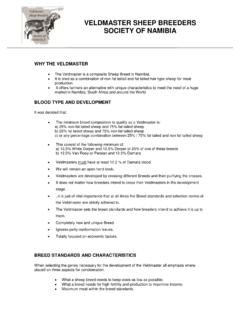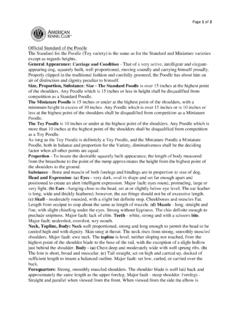Transcription of Monoliths: A new breed of separation media for ...
1 Monoliths: A new breed of separation media for chromatography by frantisek Svec, lawrence berkeley national laboratory Monoliths are separation media in the format that can be compared to a single large particle that does not contain interparticular voids. As a result, all the mobile phase must flow through the stationary phase. This convective flow greatly accelerates the rate of mass transfer. In contrast to diffusion, which is the typical driving force for mass transfer within the pores of particulate stationary phases during chromatographic processes, convective flow through the pores enables a substantial increase in the speed of the separation . The first thoughts related to what we today call monoliths can be traced down to the works of the Nobel Price winner Richard Synge who in 1952 envisioned a continuous block of porous gel structure [1]. First attempts to make single-piece stationary phase from highly swollen polymer gel and open-pore polyurethane foams during the late 1960s and the early 1970s were less successful.
2 Interest in the monolithic formats has only been revived in the late 1980s when novel approaches towards true monoliths such as compressed hydrophilic gels, macroporous polymer discs, columns, tubes, as well as silica rods, have been developed [2]. Recently, a distinct trend to miniaturization and application of monolith in capillary and microfluidic formats can be observed. shows porous polymer monolith in microfluidic channel of a chip. The photoinitiated polymerization process via which this monolith was prepared, enables patterning of the monolith within the device and also allows for the preparation of fluidic systems with multiple chemistries and/or functions. The first microanalytical monolithic devices were capillary columns for electrochroma-tography. CEC practitioners who had switched from HPLC and CE quickly realized that creating retaining frits in capillaries and packing stable microcolumns with beads were very challenging. This spurred the development of alternative column technologies including monolithic separation media prepared in situ.
3 As a result of their unique properties and simplicity of preparation, monolithic columns attracted considerable attention, and a plethora of chemistries and approaches soon became available [3]. CEC appears to be extremely useful in applications where high column efficiency can make a big difference such as the proteomic separation of complex peptide and/or glycan mixtures, followed by MS detection. In addition, electrochromatography is easily amenable to microfluidic chips since it does not require external pumps to achieve flow through the device. Fig. 2 illustrates the power of CEC with the separation of tryptic digest of cytochrom C. Fig. 1. SEM micrograph of porous polymer monolith in a COC microfluidic chip. min246mAU01020304050608101214min246mAU01 020304050608101214 Fig. 2. CEC separation of tryptic digest of cytochrome C using a polyacrylate based monolithic capillary column. NanoHPLC is another domain where monolithic columns are gaining attention.
4 Once again, the simplicity of the in situ preparation easily defeats quite cumbersome packing of narrow bore capillaries with particles. Even more important is the excellent permeability of monolithic columns to flow. While a 20 m capillary column packed with sub 2 m particles may be difficult to run in standard chromatographic equipment due to excessive back pressure, a monolithic column exhibits manageable back pressure even at a column length of 10 cm [4]. Probably the best demonstration of the performance of a monolithic column is the reversed phase separation of tryptic digest of a microorganism Shewanella oneidensis in a 70 cm long, 20 m silica based monolith. The separation in a 750 min long gradient enabled the identification of 2367 different peptides covering 855 distinct proteins [5]. Another current trend in applications of monolith focuses on narrow bore open tubular columns with a monolithic porous polymer layer and their use in both CEC and nanoLC [6,7].
5 This approach enables use of long very narrow bore capillary columns. For example, a m long, 10 m column with poly(styrene-co-divinylbenzene) layer enabled excellent separation of protein digests. The last example of the emerging applications is use of monolith as a thin layer for the TLC separation [8]. Formation of monolith on the top of a glass plate is again very simple. A mold consisting the support plate, a gasket, and a top plate is filled with the polymerization mixture and irradiated with UV light. The layer can be immediately used not only for the traditional separation of small molecules but also for the separation of peptides and proteins. The detection is then achieved using MALDI MS. The above lines are supposed to give the reader a glimpse of the wealth of formats and applications of current porous monoliths. It is very likely that they will further grow in the future since more and more scientists are recognizing the beauty, versatility, and simplicity of these materials.
6 [1] Mould, Synge, Analyst. 77 (1952) 964. [2] F. Svec, Tennikova, Z. Deyl, Monolithic Materials: Preparation, Properties, and Applications. Elsevier, Amsterdam, 2003. [3] Z. Deyl, F. Svec, Capillary Electrochromatography. Elsevier, Amsterdam, 2001. [4] , , , , J. Chromatogr. A 1154 (2007) 295. [5] Q. Luo, Y. Shen, Hixson, R. Zhao, F. Yang, Moore, Mottaz, , Anal. Chem. 77 (2005) 5028. [6] B. Eeltink, F. Svec, Fr chet, Electrohoresis 27 (2006) 4249. [7] G. Yue, Q. Luo, J. Zhang, , Karger, Anal. Chem. 79 (2007) 938. [8] R. Bakry, Bonn, D. Mair, F. Svec, Anal. Chem. 79 (2007) 486. Dr. frantisek Svec The Molecular Foundry lawrence berkeley national LabBerkeley, CA






